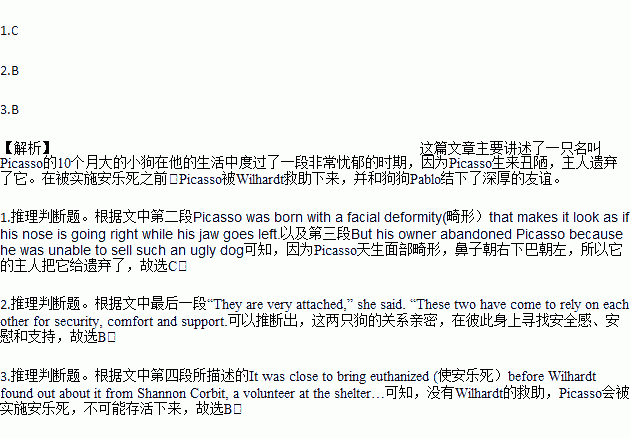题目内容
A 10-month-old dog named Picasso is exiting a very blue period in his life, thanks to an Oregon dog rescue group.
Picasso was born with a facial deformity(畸形) that makes it look as if his nose is going right while his jaw goes left. Except for that, Picasso is healthy, according to Liesl Wilhardt, director of Luvable Dog Rescue. “He can eat sideways, but he’s a very messy eater,” she said. “Same with water.”
Picasso was one of the five baby dogs born last year in Porterville, California. But his owner abandoned Picasso because he was unable to sell such an ugly dog, and it was taken to the Porterville Animal Animal Shelter.
It was close to being euthanized (使安乐死)before Wilhardt found out about it from Shannon Corbit, a volunteer at the shelter. “I asked her if she had any dogs with special needs, because I felt we could take some on,” Wilhardt said. “She said, ‘Yeah, there’s a dog with a facial deformity, ’and I fell in love with his picture. ”
That as two weeks ago. Since then, Picasso's unique look has made him widely known online. Even so, there are plans to have that upper canine(犬齿) removed in the near future. Once Picasso’s tooth is fixed, he and Pablo, another dog, will be put up for adoption.
“They are very attached,” she said. “These two have come to rely on each other for security, comfort and support. Both dogs are perfect for an active family with older kids. Picasso is outgoing, happy, curious and lovely. He’s so unaware of how different he is.”
1.Why was Picasso abandoned by its owner?
A. Because of its poor health.
B. Because of its super appetite.
C. Because of its facial deformity.
D. Because of its fierce character.
2.What conclusion ran be drawn from the last paragraph?
A. Picasso is ashamed of his own appearance.
B. Picasso and Pablo are closely bonded.
C. Picasso is a good playmate for young children.
D. Picasso knows the difference between him and other dogs.
3.What can be inferred from the text?
A. What has made Picasso famous is his suffering.
B. Picasso wouldn’t be alive today without Wilhardt.
C. Picasso and Pablo were horn in an animal shelter.
D. Wilhardt was really scared on seeing Picasso1 s picture.
| A. | are being built | B. | will be built | C. | have been built | D. | had been built |


 ted to lovers only.
ted to lovers only.